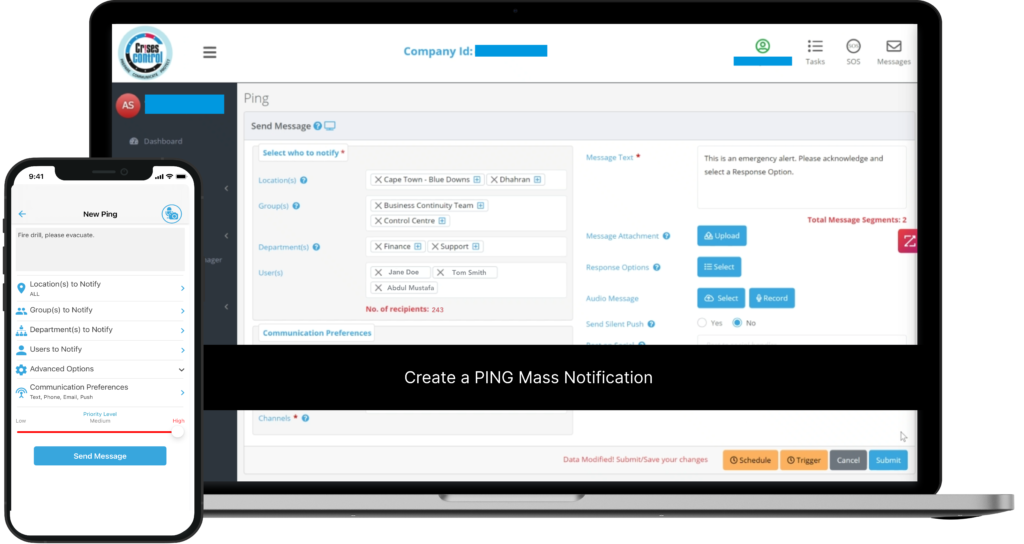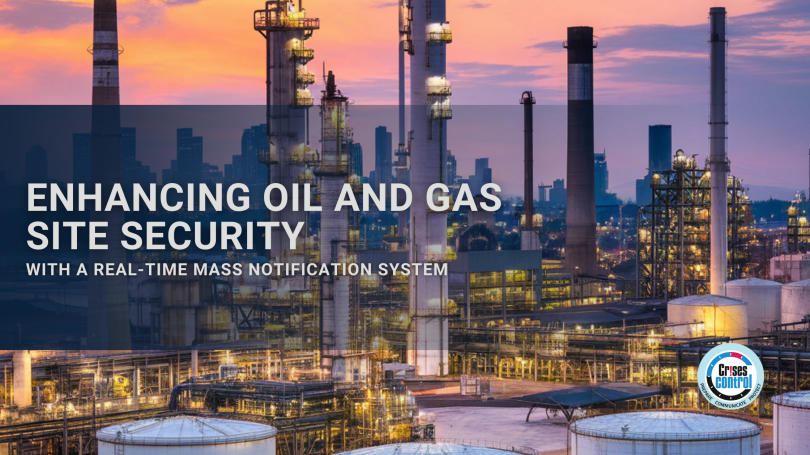Written by Ikram Tassi, Marketing
Why Site Security in Oil and Gas Requires a Real-Time Approach
The oil and gas industry operates in high-stakes, remote environments where even a brief delay in response can lead to serious consequences. From security breaches to environmental disasters, this industry faces constant threats that require rapid, reliable communication. Traditional methods like emails or phone chains simply don’t meet the needs of oil and gas sites, where complex operations and dispersed workforces need more than one channel to stay informed. Mass notification systems provide an effective solution, delivering critical information in real-time to keep personnel and assets secure.
In this blog, we’ll explore why real-time mass notification systems are crucial to oil and gas site security and show how Crises Control’s Ping Mass Notification system addresses the unique challenges of this industry.
Why Real-Time Alerts Are Crucial for Oil and Gas Security
Understanding the Security Risks in Oil and Gas
The oil and gas industry faces unique and varied security challenges, including:
- Industrial Accidents: Fires, equipment malfunctions, and hazardous material leaks that demand immediate attention.
- Environmental Disasters: Incidents like oil spills or pipeline ruptures, which can have significant environmental impacts if not managed swiftly.
- Security Breaches: Unauthorised access, sabotage, and even terrorist threats that require fast, coordinated action.
With large, often isolated workforces spread across multiple sites, any delay in communication during an emergency could lead to severe consequences. Real-time mass notifications can make a difference in these environments by providing quick, clear, and multi-channel communication that saves lives and protects assets.
How Mass Notification Systems Provide Critical Security Solutions
1. Instant Alerts Through Multi-Channel Communication
In a crisis, every second counts, especially in a widespread and potentially hazardous industry like oil and gas. A single communication method, like email, may be too slow or unreliable to alert everyone on time, especially across remote or offshore locations. This is where the importance of multi-channel communication comes in.
With Crises Control’s Ping Mass Notification system, alerts are sent through multiple channels at once—SMS, email, mobile app notifications, voice calls, and web-based alerts. This multi-channel approach ensures that everyone, regardless of location or device, receives messages without delay. By reaching employees through different channels, you minimise the risk of communication failures.
Consider a security breach or an equipment failure on an oil rig: with real-time alerts delivered across all these channels, you can inform offshore and onshore teams instantly, allowing for quick, coordinated action. The mobile app feature even reaches workers in areas where traditional methods, like email, might be unreliable or fail entirely.
Crises Control also allows companies to create pre-configured templates for common emergencies, like fires or gas leaks, automating the alert process. This automated mass alert capability speeds up information sharing, so employees can respond without delay.
2. Geo-Targeting for Precision Responses
Oil and gas sites are massive and can span miles, like oil refineries, processing plants, or extensive pipelines. When incidents happen, they’re often contained to specific areas. Geo-targeting allows Crises Control’s Ping Mass Notification system to send alerts only to those employees in affected zones, while others remain undisturbed.
Geo-targeted notifications prevent unnecessary panic and confusion across the workforce. For example, if a fire breaks out in a particular section of an oil refinery, only the employees in that area will receive evacuation alerts. This approach keeps unaffected parts of the facility running smoothly, saving time and minimising productivity losses.
Geo-targeting is also critical for pipelines or rigs that stretch across remote locations. In the event of a pipeline rupture, for example, a geo-targeted alert can notify workers in the impacted area, enabling a quick evacuation. Meanwhile, the rest of the workforce remains informed, but undisturbed, reducing unnecessary disruptions.
The Crises Control dashboard visualises affected areas in real-time, allowing managers to monitor incident zones and direct resources precisely where they’re needed.
3. Two-Way Communication for Real-Time Updates
Effective crisis management requires two-way communication, especially in dynamic situations where on-the-ground feedback can impact response decisions. Crises Control’s Ping system enables two-way communication, allowing employees to acknowledge receipt of alerts, share status updates, and request assistance when needed. This feedback loop ensures a more informed response, as managers receive real-time updates on changing conditions.
For instance, during a fire or a hazardous material leak, employees can instantly confirm their location and safety status, alerting managers to areas where help is required. In one real-world scenario, Crises Control’s two-way communication allowed offshore workers to quickly confirm their safety following a gas leak, streamlining the crisis response and ensuring that critical resources were allocated efficiently.
The system’s two-way communication feature provides managers with a complete view of the situation, enabling faster, data-driven decision-making and giving them a clear picture of employee status, even in remote areas.
Interested in our Ping Mass Notification System?
Efficiently alert everyone in seconds at scale with our Mass Notification System – PING, get the message out fast and ensure rapid response and recovery.

Crises Control’s Ping Mass Notification: Tailored for Oil and Gas Security
1. Integration with Existing Security Infrastructure
Oil and gas sites often use multiple security systems, from CCTV and access control to fire alarms and environmental monitoring devices. Crises Control’s Ping Mass Notification system seamlessly integrates with these existing systems, creating a unified crisis response platform.
For instance, by integrating with access control, Crises Control can automatically lock down specific areas in case of a security breach, while simultaneously notifying all affected staff. When connected to fire alarms, it ensures that notifications are sent to the right personnel the moment a fire is detected, triggering evacuation protocols.
This integration reduces the time between detecting an incident and responding to it, streamlining the entire process. Instead of switching between different systems, Crises Control allows managers to handle them all from one dashboard, giving them complete control over every aspect of the crisis response.
2. Detailed Reporting for Post-Incident Analysis
After a crisis has been handled, oil and gas companies need to conduct a thorough analysis to understand what worked well and where improvements are necessary. Crises Control provides detailed reports on every notification sent, tracking who received it and how they responded. This data enables companies to evaluate their response performance and make data-driven adjustments to future protocols.
For oil and gas operations, these reports ensure compliance with regulatory requirements and help improve future crisis response. For instance, in a security breach, a company can review the timeline and effectiveness of communication to identify any delays or missed steps. Having these detailed records also proves beneficial for insurance purposes, documenting the company’s rapid response and commitment to safety.
Secure Your Oil and Gas Sites with Crises Control
Oil and gas operations come with unique challenges that require proactive and precise communication solutions. Crises Control’s Ping Mass Notification system addresses these needs, offering a powerful suite of features like multi-channel alerts, geo-targeting, and two-way communication. Together, these capabilities ensure that personnel and assets are protected at all times.
The real-time, multi-channel communication keeps employees informed wherever they are, geo-targeting reduces unnecessary panic, and integration with existing systems streamlines the crisis response. Crises Control’s comprehensive solution equips oil and gas companies with the tools they need to react quickly and confidently to any situation.
Ready to secure your site and protect your workforce? Contact us today for a free demo of Crises Control’s Ping Mass Notification system and see how we can help safeguard your operations.
Request a FREE Demo

